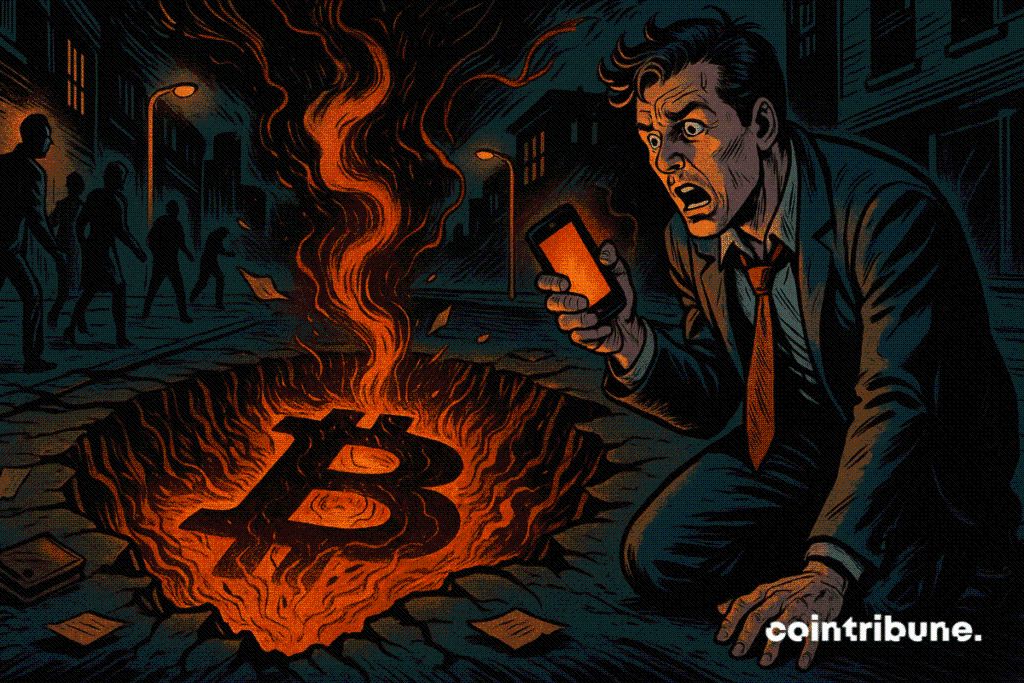Bitcoin Dips Below ETF Cost-Basis Levels
Bitcoin has just reached 86,000 dollars, a pivotal threshold that places the asset at the heart of an area referred to as “max pain” by several analysts. In a climate of monetary tension, this drop fuels fears of an imminent institutional capitulation.

In Brief
- Bitcoin retreats to 86,000 dollars, crossing a sensitive technical threshold that alerts analysts.
- This decline brings BTC closer to a critical zone between $84,000 and $73,000, called “max pain”.
- These levels correspond to the acquisition costs of BlackRock (IBIT) and Strategy, with increased risk of massive sell-offs.
- Uncertainty around the next Fed decision increases pressure on the crypto market.
Bitcoin Between $84,000 and $73,000 : A Zone of Maximum Tension
The recent Bitcoin correction down to 86,000 dollars brings it dangerously close to what some analysts call a “max pain” zone.
For André Dragosch, head of research at Bitwise Europe, this pivotal zone lies between 84,000 dollars, the average acquisition cost of BlackRock’s ETF (IBIT), and 73,000 dollars, that of Strategy’s Bitcoin treasury.
“The max pain zone is located between two average capital acquisition cost levels : “$84,000 for IBIT, BlackRock’s ETF, and about $73,000 for Strategy”, he explained.
These key technical levels come with increased risk of massive sell-offs if the market continues its decline. Here are the major points to remember about this critical zone :
- $84,000 : average purchase level of the iShares Bitcoin Trust (IBIT), BlackRock’s ETF. Approaching this threshold, institutional investors begin to reconsider their positions, increasing the risk of massive buybacks ;
- $73,000 : the average acquisition price of Strategy’s Bitcoin treasury, a company heavily exposed to BTC volatility. If this threshold is reached, it could increase pressure on the stock and the market ;
- Dragosch believes a cycle low could materialize in this zone, indicating a form of forced cleaning of overly optimistic positions ;
- Entry into this range could worsen ETF holders’ nervousness and trigger a liquidation spiral, or disengagements typical of capitulation periods.
This “max pain zone” reflects a form of psychological threshold for major market players. If it were breached sustainably, it could mark a technical bottom but also test the resilience of institutional demand. For now, the market is moving on the edge of this zone in an atmosphere of extreme tension.
A Worrisome Conjunction
While the tension around technical levels is palpable, it is exacerbated by worrying signals on the capital flow side.
The iShares Bitcoin Trust (IBIT), an ETF launched by BlackRock, logged its worst net outflow day last Tuesday, with withdrawals of $523 million. This movement fits into a general trend: cumulative outflows across all spot Bitcoin ETFs reached $3.3 billion in one month, around 3.5% of total assets under management.
This dynamic is aggravated by the situation of Strategy, whose net asset value (NAV) has fallen below 1. In other words, the market now values its shares below the bitcoin value they represent, signaling marked distrust and a gradual drying up of liquidity.
Added to this is macroeconomic uncertainty. After a government shutdown delayed key employment data, the next FOMC meeting in December will be decisive. Thus, the probability of a rate cut has fallen to 41.8% , leaving the risk of a monetary status quo that could prolong tension on risk markets.
In such a context, short-term prospects for bitcoin remain constrained by market conditions. If liquidity remains limited, BTC’s trajectory might oscillate between $60,000 and $80,000 until year-end. However, some contrary signals are emerging: reserves of stablecoins on exchanges reach a record high of $72 billion, a level historically associated with the onset of strong bullish recoveries.
Disclaimer: The content of this article solely reflects the author's opinion and does not represent the platform in any capacity. This article is not intended to serve as a reference for making investment decisions.
You may also like
$8.8 billion outflow countdown: MSTR is becoming the abandoned child of global index funds
The final result will be revealed on January 15, 2026, and the market has already started to vote with its feet.

Deconstructing DAT: Beyond mNAV, How to Identify "Real vs. Fake HODLing"?
There is only one iron rule for investing in DAT: ignore premium bubbles and only invest in those with a genuine flywheel of continuously increasing "crypto per share."

Empowered by AI Avatars, How Does TwinX Create Immersive Interaction and a Value Closed Loop?
1. **Challenges in the Creator Economy**: Web2 content platforms suffer from issues such as opaque algorithms, non-transparent distribution, unclear commission rates, and high costs for fan migration, making it difficult for creators to control their own data and earnings. 2. **Integration of AI and Web3**: The development of AI technology, especially AI Avatar technology, combined with Web3's exploration of the creator economy, offers new solutions aimed at breaking the control of centralized platforms and reconstructing content production and value distribution. 3. **Positioning of the TwinX Platform**: TwinX is an AI-driven Web3 short video social platform that aims to reconstruct content, interaction, and value distribution through AI avatars, immersive interactions, and a decentralized value system, enabling creators to own their data and income. 4. **Core Features of TwinX**: These include AI avatar technology, which allows creators to generate a learnable, configurable, and sustainably operable "second persona", as well as a closed-loop commercialization pathway that integrates content creation, interaction, and monetization. 5. **Web3 Characteristics**: TwinX embodies the assetization and co-governance features of Web3. It utilizes blockchain to confirm and record interactive behaviors, turning user activities into traceable assets, and enables participants to engage in platform governance through tokens, thus integrating the creator economy with community governance.

Aster CEO explains in detail the vision of Aster privacy L1 chain, reshaping the decentralized trading experience
Aster is set to launch a privacy-focused Layer 1 (L1) public chain, along with detailed plans for token empowerment, global market expansion, and liquidity strategies.

